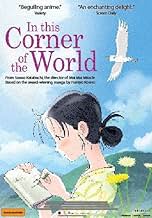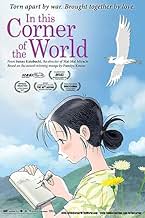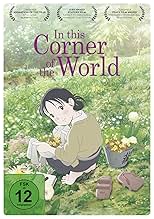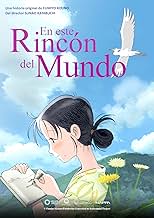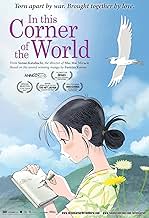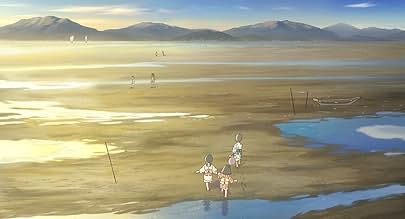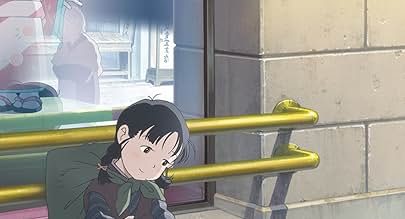AVALIAÇÃO DA IMDb
7,8/10
13 mil
SUA AVALIAÇÃO
Adicionar um enredo no seu idiomaA spirited 18-year-old woman is married off to a man she barely knows as she combats the daily struggles of living in Hiroshima during World War II.A spirited 18-year-old woman is married off to a man she barely knows as she combats the daily struggles of living in Hiroshima during World War II.A spirited 18-year-old woman is married off to a man she barely knows as she combats the daily struggles of living in Hiroshima during World War II.
- Direção
- Roteiristas
- Artistas
- Prêmios
- 10 vitórias e 11 indicações no total
Ava Pickard
- Suzu (Young)
- (English version)
- (narração)
Kenna Pickard
- Harumi
- (English version)
- (narração)
Karen Strassman
- Rin
- (English version)
- (narração)
Melodee Spevack
- Kiseno
- (English version)
- (narração)
Michael Sorich
- Juro
- (English version)
- (narração)
Tony Azzolino
- Yoichi
- (English version)
- (narração)
Anne Yatco
- Additional Voices
- (English version)
- (narração)
Bailey Bucher
- Additional Voices
- (English version)
- (narração)
Bryce Papenbrook
- Additional Voices
- (English version)
- (narração)
Cherami Leigh
- Additional Voices
- (English version)
- (narração)
Christopher Corey Smith
- Additional Voices
- (English version)
- (narração)
- (as Christopher Smith)
Cindy Robinson
- Additional Voices
- (English version)
- (narração)
Cristina Valenzuela
- Additional Voices
- (English version)
- (narração)
Dane Price
- Additional Voices
- (English version)
- (narração)
Dorothy Elias-Fahn
- Additional Voices
- (English version)
- (narração)
- (as Johanna Luis)
Joe Ochman
- Additional Voices
- (English version)
- (narração)
- (as Joseph Whimms)
Julie Ann Taylor
- Additional Voices
- (English version)
- (narração)
- Direção
- Roteiristas
- Elenco e equipe completos
- Produção, bilheteria e muito mais no IMDbPro
Avaliações em destaque
Greetings again from the darkness. There is something hypnotic about the hand-drawn animation of writer/director Sunao Katabuchi's film based on the 2007-09 Japanese manga (comic) by Fumiyo Kouno. With some similarities to Takahata's 1988 classic Grave of the Fireflies, it's more than a wartime drama – it's a story of the human spirit.
It's 1935 and Suzu is a young girl who lives in Eba, a town in Hiroshima. She is an exceptional artist with a vibrant imagination and an adventurous approach to life. Her innocence and pleasant childhood existence is rocked when, as a teenager, she receives an out-of-the-blue marriage proposal from a stranger. Life with his family in Kure forces Suzu into a daily routine of cleaning, mending and cooking – all while longing for her family in Eba.
The film clicks through the months and years, and provides a history of war time from the perspective of a family and village. While the date of August 6, 1945 hovers on the viewer's mind, we experience how family dynamics are affected by war time. For Suzu, her daily routines such as food preparation provide a necessary structure and distraction, despite the ever-worsening shortage of food and supplies. These stresses are compounded by air raid warnings over the radio and Suzu suffers through vivid nightmares.
We so easily connect with Suzu as she continually fights through hardships – both physical and emotional – because of her determination to live a good life and overcome all obstacles. This is such expert story telling with a beautiful presentation, that the film periodically reminds us that war is close by. Even in a war torn country, the people must find a way to go about daily life while treasuring the rare moments of joy and understanding the strength of togetherness. It's rare that an animated movie can deliver such a humanist look at fully formed characters and their feelings all within a historical setting.
It's 1935 and Suzu is a young girl who lives in Eba, a town in Hiroshima. She is an exceptional artist with a vibrant imagination and an adventurous approach to life. Her innocence and pleasant childhood existence is rocked when, as a teenager, she receives an out-of-the-blue marriage proposal from a stranger. Life with his family in Kure forces Suzu into a daily routine of cleaning, mending and cooking – all while longing for her family in Eba.
The film clicks through the months and years, and provides a history of war time from the perspective of a family and village. While the date of August 6, 1945 hovers on the viewer's mind, we experience how family dynamics are affected by war time. For Suzu, her daily routines such as food preparation provide a necessary structure and distraction, despite the ever-worsening shortage of food and supplies. These stresses are compounded by air raid warnings over the radio and Suzu suffers through vivid nightmares.
We so easily connect with Suzu as she continually fights through hardships – both physical and emotional – because of her determination to live a good life and overcome all obstacles. This is such expert story telling with a beautiful presentation, that the film periodically reminds us that war is close by. Even in a war torn country, the people must find a way to go about daily life while treasuring the rare moments of joy and understanding the strength of togetherness. It's rare that an animated movie can deliver such a humanist look at fully formed characters and their feelings all within a historical setting.
For a film that takes on a big and heavy-going part of history, I have to say I was very impressed with how sweet and touching In This Corner Of The World is. Although it's never an emotionally exhilarating experience, it brings a very nostalgic and intimate story to light with some beautiful animation and a unique look at the years before the bombing of Hiroshima, all making for a thoroughly engrossing and affecting film.
But first, let's just get across what doesn't quite work about this film. It's definitely important to know that this isn't an account of the Hiroshima bombing itself, nor is it a heavy-going war drama on par with something like Grave Of The Fireflies. That said, the first half of this movie doesn't quite deliver a strong enough story to make its more personal focus so enthralling.
As sweet and nostalgic as the film is, and as clever as using the historical hindsight to watch people live out their daily lives innocently in the old Hiroshima is, the plot for the first half just doesn't really take you anywhere. It's a pleasant and pretty account coming of age story, but it's a little too much like a slice-of-life drama to really give you that strong emotional connection to the characters right from the beginning, meaning that the film does take quite a while to really get going.
That said, once it shifts up into a more dramatic gear, things become very impressive. Now contrasting the hardships of a war context with the life that this young girl was building for herself, the film taps into an emotion that's rarely focused on, bringing a sombre atmosphere to what was such a sweet and pleasant story of nostalgia, by showing you what the true loss of war can be: an entire community filled with lives flourishing all over taken away.
And yet, the film remains surprisingly heartwarming even when it gets into some of the heavier-going parts of the history. Whilst there are many really sad moments that tug at your heartstrings, the determination of our main character as she negotiates an unimaginably harrowing situation is so uplifting, and brings out a brilliant beauty amidst all of the horror of war.
Which brings me to the animation. Styled in a similar fashion to many of Studio Ghibli's best works, this film not only looks beautiful, but its animation style plays a big part in its story. Throughout the film, we learn how the young girl loves to draw, which is even more apparent against the beautiful hand-painted landscapes.
But from her love of drawing come a series of stunning sequences in which we see the Japanese navy ships, as well as aerial battles and air-raids in the skies above Hiroshima turned into delightful and colourful paintings seen from the eyes of this young girl, heightening the sense of sadness when you think about such a happy and kind- natured character having her life turned completely upside down by the war.
Finally, when it comes to the atomic bombing of Hiroshima, I think that this film handled itself very well. In keeping with the notion that it's not a direct story about the event on the August 6th, 1945, the very moment itself isn't shown explicitly, and we continue to focus on the confused and gradually beleaguered people living in the city on the outskirts of Hiroshima.
Yes, the story does still bring to light the horrors of the aftermath of the bombing, but in that it continues to show some beautifully heartwarming and uplifting moments that emerge from the terror, and in the film's finale, it really shines with a bold and brave but utterly stunning demonstration of the strength of decent human beings in the face of the worst possible adversity.
Overall, I was very impressed by this film. Although it gets off to a very slow start, it compensates with a beautifully-executed second half, using the sweet and nostalgic nature of the first act to tug at your heartstrings when everything turns dark, and with the gorgeous animation style from start to finish, this film is a truly touching watch.
But first, let's just get across what doesn't quite work about this film. It's definitely important to know that this isn't an account of the Hiroshima bombing itself, nor is it a heavy-going war drama on par with something like Grave Of The Fireflies. That said, the first half of this movie doesn't quite deliver a strong enough story to make its more personal focus so enthralling.
As sweet and nostalgic as the film is, and as clever as using the historical hindsight to watch people live out their daily lives innocently in the old Hiroshima is, the plot for the first half just doesn't really take you anywhere. It's a pleasant and pretty account coming of age story, but it's a little too much like a slice-of-life drama to really give you that strong emotional connection to the characters right from the beginning, meaning that the film does take quite a while to really get going.
That said, once it shifts up into a more dramatic gear, things become very impressive. Now contrasting the hardships of a war context with the life that this young girl was building for herself, the film taps into an emotion that's rarely focused on, bringing a sombre atmosphere to what was such a sweet and pleasant story of nostalgia, by showing you what the true loss of war can be: an entire community filled with lives flourishing all over taken away.
And yet, the film remains surprisingly heartwarming even when it gets into some of the heavier-going parts of the history. Whilst there are many really sad moments that tug at your heartstrings, the determination of our main character as she negotiates an unimaginably harrowing situation is so uplifting, and brings out a brilliant beauty amidst all of the horror of war.
Which brings me to the animation. Styled in a similar fashion to many of Studio Ghibli's best works, this film not only looks beautiful, but its animation style plays a big part in its story. Throughout the film, we learn how the young girl loves to draw, which is even more apparent against the beautiful hand-painted landscapes.
But from her love of drawing come a series of stunning sequences in which we see the Japanese navy ships, as well as aerial battles and air-raids in the skies above Hiroshima turned into delightful and colourful paintings seen from the eyes of this young girl, heightening the sense of sadness when you think about such a happy and kind- natured character having her life turned completely upside down by the war.
Finally, when it comes to the atomic bombing of Hiroshima, I think that this film handled itself very well. In keeping with the notion that it's not a direct story about the event on the August 6th, 1945, the very moment itself isn't shown explicitly, and we continue to focus on the confused and gradually beleaguered people living in the city on the outskirts of Hiroshima.
Yes, the story does still bring to light the horrors of the aftermath of the bombing, but in that it continues to show some beautifully heartwarming and uplifting moments that emerge from the terror, and in the film's finale, it really shines with a bold and brave but utterly stunning demonstration of the strength of decent human beings in the face of the worst possible adversity.
Overall, I was very impressed by this film. Although it gets off to a very slow start, it compensates with a beautifully-executed second half, using the sweet and nostalgic nature of the first act to tug at your heartstrings when everything turns dark, and with the gorgeous animation style from start to finish, this film is a truly touching watch.
"In This Corner of the World" is one of the most beautiful anime I have ever seen. It is a story that will touch the heart of the viewer, a story that tells what seems a simple story, but that has layers and more layers in it, and that will stay with you for a long time after the end credits roll.
The story centers on Suzu, a young girl from Hiroshima, before, during and after the Second World War. She has a brother and a sister, she loves to paint and draw (and is a real artist), she enjoys simple things and has an easy smile, she just wants to be happy and help the ones that surround her.
However, life is never so simple and here, the war comes into play. And "In This Corner of the World" does a great job in balancing the small (Suzu) with the big (Hiroshima, the war and its consequences...). Even if Suzu is almost always there, on the screen, many little details, small conversations, and the interaction between characters depict a world of violence, of hate, of power and unresolved conflict. It is sad, it is touching and it shouldn't be a surprise if it makes you cry.
The animation is amazing. It is all very cute and smily, which makes the hard moments hit harder, the sad moments be sadder, and the angry moments make you angrier. The color palette, and the character's expressions help to bring the story to life and to make all of them feel real and close and their needs and desires truthful.
It is a great movie and totally worth viewing. Highly recommended.
The story centers on Suzu, a young girl from Hiroshima, before, during and after the Second World War. She has a brother and a sister, she loves to paint and draw (and is a real artist), she enjoys simple things and has an easy smile, she just wants to be happy and help the ones that surround her.
However, life is never so simple and here, the war comes into play. And "In This Corner of the World" does a great job in balancing the small (Suzu) with the big (Hiroshima, the war and its consequences...). Even if Suzu is almost always there, on the screen, many little details, small conversations, and the interaction between characters depict a world of violence, of hate, of power and unresolved conflict. It is sad, it is touching and it shouldn't be a surprise if it makes you cry.
The animation is amazing. It is all very cute and smily, which makes the hard moments hit harder, the sad moments be sadder, and the angry moments make you angrier. The color palette, and the character's expressions help to bring the story to life and to make all of them feel real and close and their needs and desires truthful.
It is a great movie and totally worth viewing. Highly recommended.
This is by no means the first animated film from Japan about life in that country during the Second World War. Isao Takahata's Grave of the Fireflies came out in 1988, and while there are similarities, there are also many differences.
The lead character is called Suzu and we follow her life in and around Kure and Hiroshima before, during and after Japan's involvement in the Second World War. While there is no mention of the attack on Pearl Harbour, America's attacks on mainland Japan are shown in graphic detail. The hardship and suffering of the civilian population is the main focus of the film and punches are definitely not pulled.
All in all a great animated film, personally I'm going to try to watch more films directed by Sunao Katabuchi.
The lead character is called Suzu and we follow her life in and around Kure and Hiroshima before, during and after Japan's involvement in the Second World War. While there is no mention of the attack on Pearl Harbour, America's attacks on mainland Japan are shown in graphic detail. The hardship and suffering of the civilian population is the main focus of the film and punches are definitely not pulled.
All in all a great animated film, personally I'm going to try to watch more films directed by Sunao Katabuchi.
Suzu is a young girl living in a peaceful seaside Japanese city. It's revealed to be pre-war Hiroshima. Her family farms seaweed. At 18, she receives a marriage proposal from a relative stranger, a young earnest man from Kure who fell in love with her at first sight. She marries and moves in with his family. Kure is a Navy town and everybody works at the base. As food gets rationed, she finds ways to adapt. She continues to draw and is beloved by her adoring niece Harumi. The winds of war blow harsh as life grows ever more difficult.
The animation is simply beautiful which contrast nicely with the fear of impending doom. I really liked not naming Hiroshima at first. I'm sure everybody in Japan noticed the building right away but outside Japan, the audience may not catch on. It would be more compelling to stay silent on the city name longer. I actually expected more of a love triangle especially with that amazing sea rabbit drawing. It didn't turn out that way which is perfectly fine. I grew to like Shusaku which is exactly what Suzu does. There are some devastating drama but it also leave some heart-warming turns for the audience. Hiroshima is handled with class. It's Fireflies without the unrelenting depression.
The animation is simply beautiful which contrast nicely with the fear of impending doom. I really liked not naming Hiroshima at first. I'm sure everybody in Japan noticed the building right away but outside Japan, the audience may not catch on. It would be more compelling to stay silent on the city name longer. I actually expected more of a love triangle especially with that amazing sea rabbit drawing. It didn't turn out that way which is perfectly fine. I grew to like Shusaku which is exactly what Suzu does. There are some devastating drama but it also leave some heart-warming turns for the audience. Hiroshima is handled with class. It's Fireflies without the unrelenting depression.
Você sabia?
- CuriosidadesWith a runtime of 168 minutes, the extended version is the longest animated film ever produced.
- Versões alternativasA rumoured extended version, supposedly titled "Kono Sekai no (Sara ni Ikutsumono) Katsumi ni" ("In This Corner (and Other Corners) of the World"), has supposedly ~30 minutes of additional footage, that is reported to emphasize the relationship between Rin, Shusaku and Suzu. Slated to premiere in mid-December 2019.
- ConexõesFeatured in In This Corner: Then and Now (2017)
- Trilhas sonoraskanashikite yarikirena
by Kotringo
Principais escolhas
Faça login para avaliar e ver a lista de recomendações personalizadas
- How long is In This Corner of the World?Fornecido pela Alexa
Detalhes
- Data de lançamento
- País de origem
- Centrais de atendimento oficiais
- Idioma
- Também conhecido como
- In This Corner of the World
- Empresas de produção
- Consulte mais créditos da empresa na IMDbPro
Bilheteria
- Faturamento bruto nos EUA e Canadá
- US$ 172.147
- Fim de semana de estreia nos EUA e Canadá
- US$ 24.205
- 13 de ago. de 2017
- Faturamento bruto mundial
- US$ 19.496.308
- Tempo de duração2 horas 9 minutos
- Cor
- Mixagem de som
- Proporção
- 1.85 : 1
Contribua para esta página
Sugerir uma alteração ou adicionar conteúdo ausente

Principal brecha
By what name was Neste Canto do Mundo (2016) officially released in India in English?
Responda






